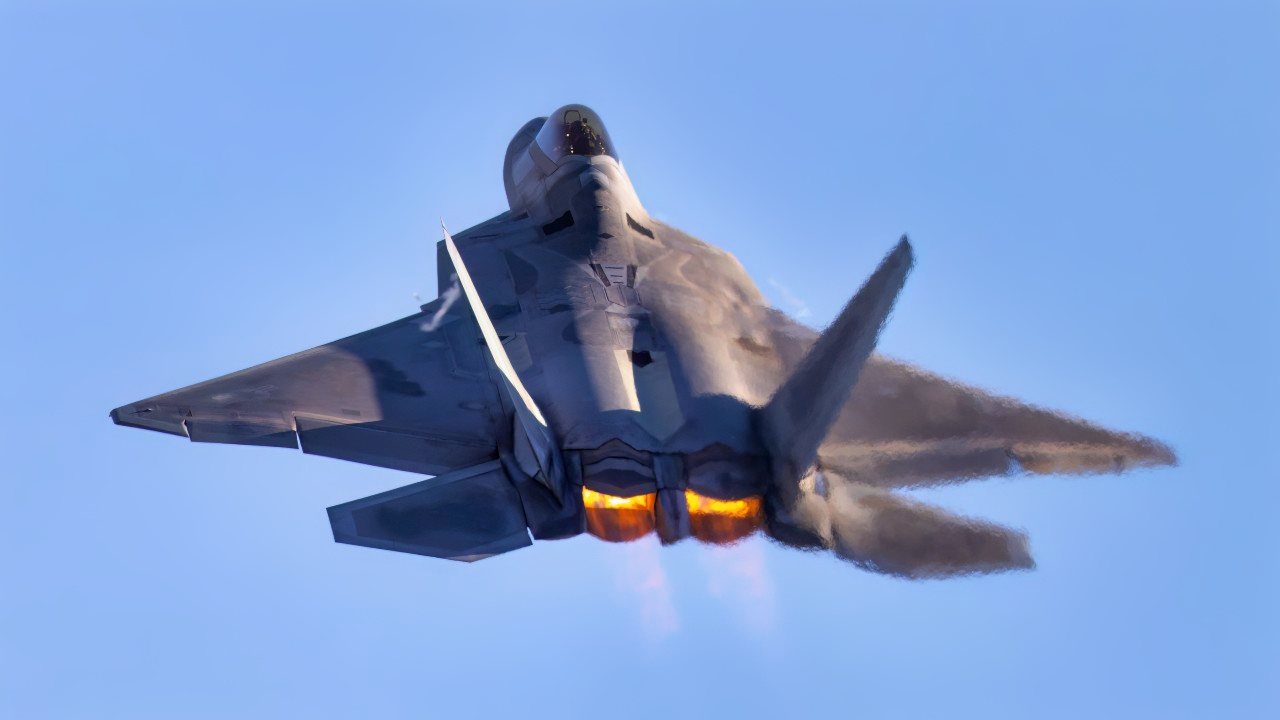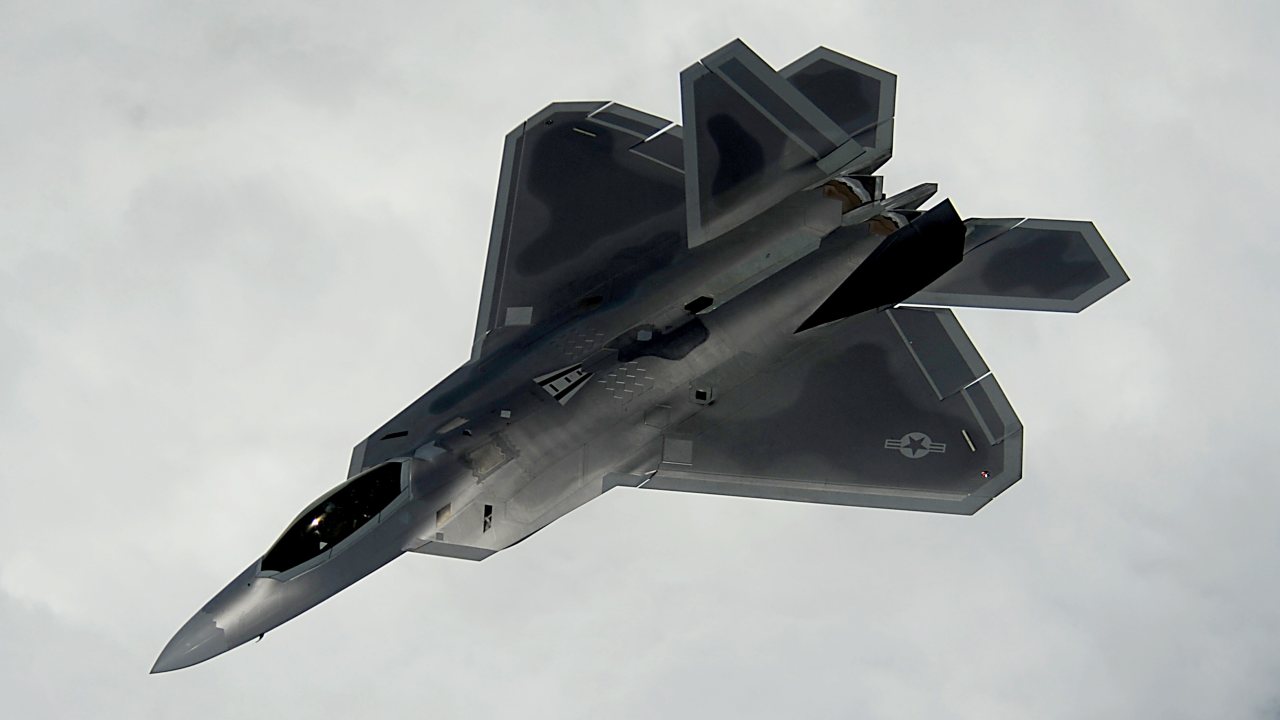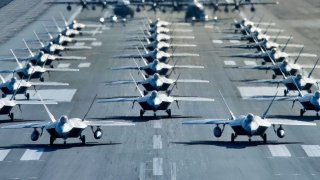China Freaked: Air Force 'Elephant Walked' 24 F-22 Fighters as 'Warning'
The F-22 Raptor, a fifth-generation air-superiority fighter, exemplifies U.S. military power with its stealth, speed, and advanced capabilities, reminding rivals of America's formidable defense capabilities.
Summary and What You Need to Know: An "Elephant Walk" is a U.S. military tradition where aircraft line up on a runway, symbolizing strength and preparedness. In 2019, during rising tensions with China, the U.S. Air Force conducted an Elephant Walk at Joint Base Elmendorf-Richardson in Alaska, showcasing 24 F-22 Raptors, a C-17 Globemaster III, and an E-3 Sentry.
-This display, strategically located near Russia, China, and North Korea, was a powerful signal of American air superiority.
-The F-22 Raptor, a fifth-generation air-superiority fighter, exemplifies U.S. military power with its stealth, speed, and advanced capabilities, reminding rivals of America's formidable defense capabilities.
America’s F-22s: The Power Behind the 2019 Alaska Elephant Walk
An elephant walk is a funny name for a unique U.S. military practice. It is a tradition going back to the Second World War.
Essentially, military aircraft line up single file on a runway for the media to report on. In the words of Simply Flying, “These events demonstrate the strength and preparedness of an Air Force, either for military or weather crises.”
In 2019, as tensions between the United States and China were escalating, the Trump administration ordered such an Elephant Walk to be conducted by the U.S. Air Force during the Polar Force exercise that year at Joint Base Elmendorf-Richardson in Alaska. The walk included a formation of F-22 Raptors, a C-17 Globemaster III, and an E-3 Sentry. It displayed half of the 3rd Wing’s Raptor Fleet.
In total, there were an astonishing 24 Raptors on the tarmac when the Elephant Walk commenced.
It was the ultimate “‘Sup China?” moment.
Context is King
The location of the Elephant Walk was important, too. It wasn’t only China that was being sent a message. It was Russia and even North Korea that were being told to watch themselves. Elmendorf’s location in Alaska, America’s last true frontier on this planet, put the Raptor fleet essentially in the backyards of those three rival powers.
And let’s face it, these countries really don’t have the kind of countermeasures to stop the Raptor if war ever broke out. The Raptor is classified as an air-superiority fighter of the fifth-generation. It was originally conceived to fight the Soviet Union in a war over Europe. Since the collapse of the USSR and end of the Cold War, though, its mission set changed somewhat – and so, too, did the needs and interests of the US Air Force.
What is an “Air Superiority Fighter”?
Air superiority fighters are primarily designed to enter and seize control of enemy airspace as part of a larger mission of establishing air dominance. They primarily achieve this goal by engaging in air-to-air combat. They gain superiority by knocking out the rival’s air force in dogfights. The F-22 is second to none in this regard.
In the post-9/11 era, though, the Pentagon came to favor America’s other fifth-generation warplane, the F-35 Lightning II, because it was also a bomber. It could both dogfight and strike targets on the ground.
But let’s not undercut the F-22. As the Air Force’s own website details, the F-22 can be reconfigured to conduct air-to-ground strikes – even carrying two 1,000-pound GBU-32 Joint Direct Attack Munitions internally to get the job done.
But as an air superiority bird, the F-22 offers a masterclass.

Having 24 of these beauties assembled on the tarmac of an airbase close to Russia, China, and North Korea, as well as its attendant transport plane and electronic warfare plane, is a clear signal to Eurasia’s autocrats that America means business.
Some of the Capabilities of the F-22
The F-22 is a stealth fighter. It has an insane avionics package. The bird can supercruise (that means it can sustain supersonic flight). It is one of the most maneuverable birds ever built, too. Hitting Mach 2 and traveling at a range of up to 1,600 miles, the F-22 is a formidable craft. Having 24 of them in a particular airspace means that unless China, Russia, or North Korea have some super-secret air defense weapon, the F-22s will annihilate whatever warplanes those countries send up to meet the F-22s.

What the Elephant Walk did was calm rising tensions and re-establish deterrence, however temporarily. The Air Force wanted 750 units of these birds when they first envisioned the program. They got a fraction of that after the production line was prematurely canceled by the Obama administration in 2009 in response to the financial crisis.
An Elephant Walk to Remember
When an enemy sees 24 Raptors ready to roll on a runway near their territory, they cannot be certain that this is just a photo-op, or if the Americans are really readying to attack with these unstoppable warbirds. While America may be a declining imperial power today, she still has capabilities that send shivers down the backs of its rivals. The power this country can wield when it chooses to is great and fearsome.
The F-22 is the modern embodiment of that power. And the Elephant Walk is a wonderful display to remind the world: Do not mess with the U.S.
Author Experience and Expertise: Brandon J. Weichert
Brandon J. Weichert, a National Interest national security analyst, is a former Congressional staffer and geopolitical analyst who is a contributor at The Washington Times, the Asia Times, and The-Pipeline. He is the author of Winning Space: How America Remains a Superpower, Biohacked: China’s Race to Control Life, and The Shadow War: Iran’s Quest for Supremacy. His next book, A Disaster of Our Own Making: How the West Lost Ukraine, is due October 22 from Encounter Books. Weichert can be followed via Twitter @WeTheBrandon.
All images are Creative Commons or Shutterstock.
From the Vault
Russia Freaked Out: Why the U.S. Navy 'Unretired' the Iowa-Class Battleships
Battleship vs. Battlecruiser: Iowa-Class vs. Russia's Kirov-Class (Who Wins?)


